| Some links below may require MS Powerpoint 2007 or Adobe Reader |
| Click on a student picture for a larger view. |

Phil CohnAdvisor: Prof. CassClassification of Game Events in Ice Hockey Game FilmWe've designed an approach to use player attributes derived from ice hockey game film with simple classification algorithms to determine what game events are depicted in given frames of film. By surveying existing work in the field of image processing we identify a series of extractable location and orientation attributes that describe each visible player in a given frame. To evaluate this approach we use machine learning techniques to try to identify predetermined game events that vary in terms of location dependence and player alignment. Manipulating attributes and introducing noise to the dataset simulates an approach that gathers player attribute information automatically using image processing techniques. We hope to expand our approach to play a primary role in a comprehensive video analysis system capable of recognizing and classifying ice hockey game events automatically for coaching purposes.
| |||

Julia DurosAdvisor: Prof. Fernandes and Prof. DvorakHave Union Students Become More T-Shaped?Interdisciplinary study benefits college students by giving them perspectives and ways of thinking that are influenced by a variety of disciplines. College administrators thus have a goal of developing programs and requirements that give students an interdisciplinary education, making them more “T- shaped” (broad and deep) rather than merely “I-shaped” (deep). The breadth of courses that students take constitutes part of what it means to be T-shaped. Aside from a student’s major requirements and General Education requirements, students choose up to half of their courses as free electives, leaving a significant amount of room for them to explore different disciplines. This project asks whether or not students are more T-shaped now than they were in the past. I obtained data by scraping all of the college’s course roster pages since the fall of 2001. For each student who has graduated since the class of 2005, information from all of their completed courses is used to evaluate the average student’s level of interdisciplinary study over time. This is measured by the breadth of courses each student took: the number of unique departments represented on their transcript. My results show that students have taken courses in a greater number of unique departments, suggesting they have become more interdisciplinary, or T-shaped.
| |||
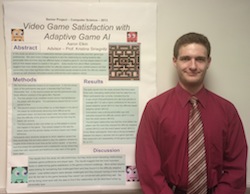
Aaron ElkinAdvisor: Prof. StriegnitzVideo Game Satisfaction with Adaptive Game AIIn this study we aimed to find a relationship between participant’s personality and their game type preferences. We used Union College students to test this relationship by having students take personality tests and then play two different types of adaptive game AI, one that adapts based on skill and on that adapts based on events in the game. Early results from about fifteen participants suggest that more skilled players prefer the difficulty adaptive variant over unskilled players and that personality had a less significant effect, but extroverted people tended to enjoy the event adaptive variant and more neurotic people were less likely to enjoy the difficulty adaptive variant.
| |||
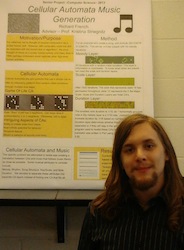
Rich FrenchAdvisor: Prof. StriegnitzCellular Automata Music GenerationFor millennia, we've thought of musical composition as a purely human activity. However, we once also thought of an activity like chess as a purely human activity, but Deep Blue was able to win a match against Kasparov in 1995 all the same. Could there perhaps be some tool or algorithm for musical composition that can replicate to some extent what human beings can do with music? This project explores this idea through the use of a tool called a cellular automaton. A cellular automaton is a grid space with a finite number of states for each of the "cells" or "squares" where a simple rule is applied, and through this rule amazingly complicated patterns emerge over many time steps. We tested the potential of these systems for choosing when and what notes to play in a musical composition. In this project, we mainly focused on creating a translator between music and cellular automata that matches music theory as closely as possible. Whether or not the tracks produced are musical could shed light on the computer's ability to replicate high-level human activities.
| |||
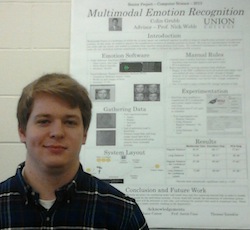
Colin GrubbAdvisor: Prof. WebbMultimodal Emotion RecognitionMultimodal fusion is the process whereby two or more forms of input are gathered together in order to produce a higher overall classification accuracy than individual unimodal systems. This is a popular technique in emotion recognition. In this study, we attempted to discover how much we could improve upon individual unimodal systems using decision level fusion. To accomplish this, we acquired two emotion classification systems, one that worked on audio input alone and another that worked on visual input, and combined their output using a set of manual rules and a classifier to achieve higher classification accuracy.
| |||
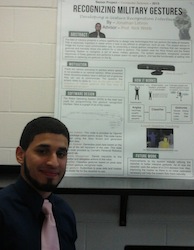
Jonathan LebronAdvisor: Prof. WebbRecognizing Military Gestures: Developing a Gesture Recognition InterfaceThe field of robotics presents a unique opportunity to design new technologies that can collaborate with humans to solve interesting problems. This is especially important in cases where a task is too difficult or dangerous, such as war. This project serves to bridge a gap within the field of Human-Robot Interaction by presenting a robust gesture recognition interface that can recognize gestures and translate these into actions for a robot to perform. The system uses the Xbox Kinect and Willow Garage’s Robot Operating System (ROS) to recognize a set of seven military gestures. My system accurately recognizes complex sequences of gestures and performs a preset action for each gesture.
| |||
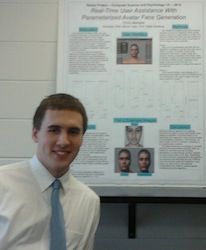
Chris MaltzanAdvisor: Prof. Cass and Prof. PerillouxReal-Time User Assistance With Parameterized Avatar Face GenerationLaw enforcement officers often rely upon untrained witnesses to provide them with leads in investigations. Right or wrong, these leads can uncover circumstantial evidence that may lead to arrests of the guilty and innocent alike. We investigated a possible alternative to the use of police sketch artists. We designed an algorithm to assist users of parameterized avatar design software package, MakeHuman. The algorithm assists users in real-time, making additional modifications to the avatar to keep the avatar's facial features within the range of what is humanly possible.
| |||
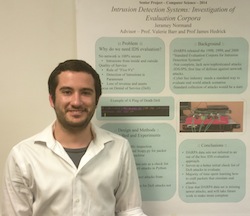
Jeramey NormandAdvisor: Prof. Barr and Prof. HedrickIntrusion Detection Systems: Investigation of Evaluation CorporaIntrusion Detection/Intrusion Prevention Systems (IDS/IPS) generally provide a network with adequate security and protection from anomalous traffic such as flooding attacks--a type of Denial of Service Attack--but they lack the ability to defend against more sophisticated Denial of Service Attacks that threaten production networks today. This is due to a lack of exhaustive and thorough evaluation techniques in the development of defense and network technology. The goal of this research is to develop a more thorough and exhaustive IDS/IPS evaluation corpora. I postulate that the currently available IDS/IPS evaluation corpora, such as DARPA ’98,’99, and ’00 and the NSL-KDD data set, are not thorough enough to act as standards, due to the narrow breadth of Denial of Service Attack (DoS) type variations they contain. Attacks created from signatures in the corpora will be launched against a network test bed to verify the network setup. Next, attack signatures of more sophisticated DoS attacks that are not present in the available corpora will be created, thus making the corpora more exhaustive and thorough.
| |||
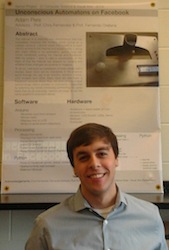
Adam PereAdvisor: Prof. Fernandes and Prof. OrellanaUnconscious Automatons on FacebookThe Internet is a relatively new phenomenon that has completely morphed the modern world. Living on a college campus, I almost never find myself in a room without access to the Internet and social media. I, along with many others in my generation, spend hours per month mindlessly surfing the Internet and Facebook. With my project, I want to start a conversation on the topic of how the Internet has shaped our society and whether these changes are positive or negative.
| |||
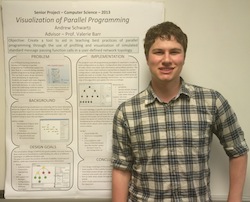
Andrew SchwartzAdvisor: Prof. BarrVisualization of Parallel ProgrammingAs advances in computer architecture near atomic limitations, parallel programming using many computation nodes in tandem is quickly becoming the future of high performance computing. Recently, parallel programming has begun being taught in computer science classrooms all over the world. Understanding the complex interactions between computers while a parallel program executes is vital to maximizing performance of the distributed system. However, students tend to have difficulty comprehending parallel concepts because professors generally have to rely on static diagrams to explain these interactions. Static representation does not adequately express parallel system behavior as it is inherently dynamic. We developed a visualizer for a virtual cluster running MPI (Message Passing Interface) algorithms in order to aid student understanding of general parallel programming concepts. The visualizer aims to provide an intuitive interface for displaying the data flow of various MPI functions in a customizable cluster configuration while also capturing and displaying benchmarking data to show the costs and benefits of different configurations. Our intention is that students using our visualizer can quickly gain a firm grasp of parallel programming concepts, which will help them develop into the programmers of the future.
|
2012 2011 2010 2009 2008 2007 2006 2005 2004 2003
Last edit 3Apr2014
Address questions or comments to tay@union.edu